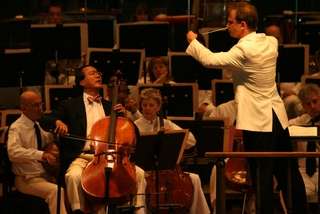|
Back
Tasting Wines Before Perle Boston
Koussevitzky Music Shed, Tanglewood, Lenox, Massachusetts
08/09/2009 -
George Perle: Sinfonietta II (in memory of the composer)
Dmitri Shostakovich: Cello Concerto No. 1 in E-flat, Opus 107
Gabriel Fauré: Elégie for Cello and Orchestra, Opus 24
George Bizet: Symphony in C
Yo-Yo Ma (Cello)
Boston Symphony Orchestra, Julian Kuerti (Conductor)

Yo-Yo Ma (with C. M. Prieto) (© Hilary Scott)
From the multitudes who did sup and tipple on the Great Lawn of the Tanglewood Festival last Sunday, the word did go out this reviewer, having been to music festivals from Albania to Morocco to Katonah to Yemen, had not once been to the Tanglewood Festival in his otherwise fecund life. And they, some 12,000-odd, did laugh with scorn.
So having not the courage to face their derision, this errant reviewer then did meander near the Merlot, saunter over the salami, amble silently by the soybeans and gingerly sniff the ginger tea on his way to the Koussevitzky Music Shed, where he did sit and think and appreciate the arboreal and musical splendors for this first time.
And he was at peace.
True, I had never been here before, but the sight of this fertile Berkshires plateau, even under cloudy skies, was thrilling. The fact that Tanglewood has been virtually a landmark in music festivals for more than 70 years has been due to nature–210 acres of forests, gardens, streams and surrounding mountains–and to humans. Specifically Serge Koussevitzky, Ozawa Seiji, and James Levine, as well as every great soloist, ensemble, composer and of course the great Boston Symphony Orchestra.
True, the multitudes come not only for the music but the picnics and ice cream and socializing. But so appreciative are they of the entire Tanglewood experience that one can forgive their applauding between the movements, or moving between the pieces. So too one can forgive the Shed, which, with its area for 5,000 people plus artists, looks more like the Augean Stables than a mere concert hall.
Although a singular experience, remember that Tanglewood is not like the British Proms or their like. The music may be well known, but it is usually great music. The audience last Sunday obviously came for Yo-yo Ma, but they were well aware that the opening work was an atonal piece, and they were certainly willing to try it out.
Not that appreciating the late George Perle’s Sinfonietta II was especially difficult. A Berkshire resident who died all too soon this year at the age of 94, Mr. Perle’s atonality, like that of his idol Alban Berg, is neither austere nor tuneless. Those who wished could have found the themes, constantly changing, yet always kept within a kind of classical structure. The two scherzos were actually jaunty, bubbling over with orchestral life (lots of snare drums and piccolo solos), and the middle section, highlighted by bass trombone and bassoon, was almost like a Bartók night music.
One of my guests, a war-correspondent cum biker whose knowledge of classical greatness is The Who, asked how to “appreciate” this music while we were driving up to Tanglewood.
“Oh,” I improvised, “for the beginning, pretend you’re on a series of back-roads with the most exotic flora, and eccentric architecture. You might find some relation between the exotic and eccentric, but just keep driving and loving the creation. In the middle, you’re on a very very slow road with only a series of clouds, no landscapes at all. Let your mind drift. Then come back to the eccentric road, go for about eight more minutes. And you’ve reached your destination.”
He later said that helped. Tanglewood generates common courtesy.
The audience, though, came for Yo-Yo Ma in two different pieces. His Shostakovich First Cello Concerto was played with a joviality in the first movement, and a searing Moderato. But he has always played it well. I heard him once under the composer’s son, and it was elegantly poetic, sheer beauty. This time, he played with a bit more toughness, though it never reached the gritty playing of Rostropovich.
But it was in the cadenza that Mr. Ma reached an apogee of sorts. Rather than the pyrotechnics which we all expect, this was a performance of breadth, spaciousness, and appreciation. Shostakovich played with all his themes here, but Mr. Ma took each in stride, ready for the triumphant ending.
His second work, after the intermission, was Gabriel Fauré’s Elégie, which does show its age. The program annotator called the theme “drooping”, and nobody could improve on that, although Mr. Ma offered an ancient Hebraic touch. But even with this questionable bagatelle, the more Yo-yo we have, the better.
Julian Kuerti led the Boston Symphony well until the final Bizet Symphony, but the first movement hardly showed him at its best. The work was languorous, informal, and sometimes even pallid. The second movement did show off the Boston Symphony strings at their most velvet. And by the time of the final Allegro vivace, Mr. Kuerti raised enough buoyant tempos and pinpoint playing to make even the ensuing traffic jams from Tanglewood easily bearable.
Harry Rolnick
|